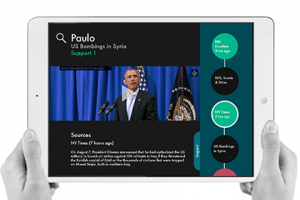|
DTM API is a musical data sonification toolset for rapid development and experimentation of web-based audio applications. The API offers a data-agnostic, adaptive, and highly interactive real-time system, with reusable and extendable musical structure models to represent data in various ways. The API is being used in several projects, including in Beltline Social Dashboard, Decatur Civic Sonification with Sonic Generator performance, which is presented at Atlanta Science Festival 2015, in collaboration with GTRI Configurable Lab. |
Through DataWorks, we hope to broaden participation in computing, and in the process, foster diverse approaches to data science, support equitable labor practices, and develop just forms of engagement between universities and communities. Website: |
Dear GamesLab: Dear Games is an educational program collaboration between Charis Circle, members of the GA Tech Game Studio and Different Games Collective. We offer inclusive events to support diverse participation in videogame developement and culture at the South's oldest independent feminist bookstore, Charis Books and More, with consideration to the ways that longstanding feminist community organizations can inform contemporary efforts to increase diversity in STEM.  |
Debate Slates is a second screen application experience designed to facilitate discussion of theories and future plot developments of long-form narrative television (e.g. Game of Thrones, True Detective and Fringe); Debate Slates also hopes to facilitate discussions on current events, focusing on televised reportage of ISIS and the developing situation in Iraq and Syria.  |
|
This project aims to define the concpet of digital self-harm for the HCI community. In this project we have explored the limited HCI scholarship related to self-harm within a social computing context. We offer the community an operatlonalized defintion of digital self-harm and propose a theoretical base to orientate related research questions into actionable activities. We also describe a research agenda for digital self-harm, highlighting how the HCI community can contribute to the understanding and designing of technologie sfor self-harm prevention, mitigation, and treatment. |
The United States' medical billing system is exceptionally complex. Medical bills and Explanation of Benefits (EOB) statements are undecipherable and incomprehensible even for experts to understand. In addition, a 2015 survey conducted by TransUnion Healthcare found that 55% of American patients were either sometimes or always confused about their medical bills and that 61% of patients were either sometimes or always surprised about their out-of-pocket costs. |
||
|
We are living in a multitasking society. We are experiencing an unprecedented level of sensory and cognitive overload, in which we have too many things going on at once, making us more likely to be absentminded. How to involve technology in promoting mindfulness and making it part of the process of achieving it is the question we need to answer in this project. |
Parents' engagement in their children's education is key to children's academic success and social development. For many parents in the U.S., engagement is still a struggle partly due to a lack of communication and community-building tools that support the broader ecology of parenting, or parental ecology. Although current technologies have the potential to create opportunities to improve parental engagement, little is known about the impact of existing technology's design onthe parental ecology. |
Using a user-centered research approach, this project explored possible scenarios for voice interaction inside cars in the next 3-5 years and developed a set of voice interaction design tools. |
|
|
This project is centered around Georgia Tech's IT Service Management Platform. The problem space revolves around inconsistencies in knowledge articles. My solution was a design system tailored for an audience with low technical expertise.  Website: |
Most public sources reporting air quality data either present the value without sufficient supports for deeper exploration of multiple pollutants or are robust data repositories that are too technical to be accessible to non-scientific audiences. Our findings indicate many people have little context for understanding how the Air Quality Index (AQI) is generated or what it measures. In response, we are creating a contextualized, visualization-based platform to support public audiences in exploring air pollution beyond the AQI by displaying contextualized multi-pollutant data. |


